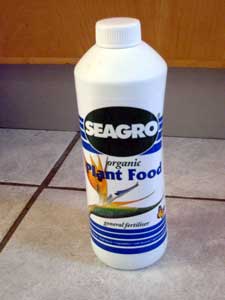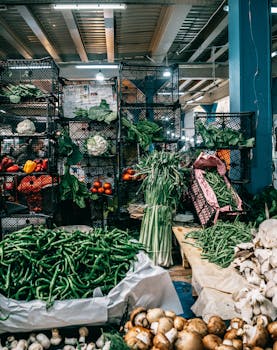Plant food is a product that contains nutrients used by plants for growth. These include the Nitrogen-Phosphorous-Potassium (NPK) macronutrients normally used in fertilizers along with some other micronutrients that plants like.
It comes in bottles, often labelled as food for certain types of plants, e.g. “rose food”. This doesn’t mean it only works with roses. It should work with other plants too.
Over Application

You can feed your plants too much. Everything in moderation! Follow the instructions on the food’s label.
How to Apply Food to Plants
When supplied in powder form, you will need to mix it with water according to the instructions. Some liquid food can be applied directly to the plant, but a lot of it also needs to be diluted. Mixing food with water to spray on the plant is effective.
Mineral Nutrients
Plants need the 13 mineral nutrients shown below for growth. In addition to this, they require the 3 non-mineral nutrients of Oxygen, Carbon and Hydrogen. The mineral nutrients come from the soil and are dissolved in water when you water the plant, finally being absorbed through the plant’s roots.
| Primary Plant Macronutrients | |||
|---|---|---|---|
| Name | Symbol | Function | Signs of Deficiency |
| Nitrogen | N | New cell formation throughout plant | Yellow-green stunted growth |
| Phosphorous | P | Development of roots and stems. Stimulates seed fruit production. | Red or purple discoloured leaves. |
| Potassium (a.k.a. Potash) | K | Strong stems, roots, deep flower colour | Weak stems, yellow/brown edges on leaves |
| Secondary Plant Macronutrients | |||
| Calcium | Ca | Plant wall structure. Normal transport and retention of other elements. Makes for strong plants | Reduced growth or death of growing tips. Poor fruit development and appearance. |
| Magnesium | Mg | Part of Chlorophyll. Essential for photosynthesis. Activates plant enzymes. | Yellowing of older leaves. Weak fruit development and production. |
| Sulphur | S | Production of protein. Promotes development of enzymes and vitamins. Helps chlorophyll formation. Improves root growth and seed production. Helps strong plant growth. Resistance to cold. | Yellowing of young leaves. |
| Plant Micronutrients | |||
| Boron | B | Assists in use of nutrients. Regulates other nutrients. Aids production of sugar and carbohydrates. Essential for fruit and seed development. Cell wall component. | Death of growing points. Deformation of leaves with decolouration. |
| Copper | Cu | Reproductive growth | Curled leaves |
| Chloride | Cl | Aids metabolism | Abnormal leaf shape. Chlorosis and wilting of young leaves. |
| Iron | Fe | Essential for synthesis of Chlorophyll. | Distinct yellow or white areas between veins of young leaves leading to spots of dead leaf tissue. |
| Manganese | Mn | Activates enzymes. Nitrogen metabolism. | Yellowing between veins. Mottling of young leaves. |
| Molybdenum | Mo | Helps in use of Nitrogen. | Mottled spotting. Interveinal chlorosis. |
| Zinc | Zn | Essential for transformation of carbohydrates. Regulates consumption of sugars. Part of enzyme systems which regulate plant growth. | Interveinal yellowing on young leaves. |
Smelly
Just a word of caution — liquid plant food can smell terrible. A lot of the organic fertilizers contain fish by-products. Just take this into account with the timing of when you fertilize. It’s not a great thing to do just before you have guests!
Article source: http://www.beginner-indoor-gardening.com/plant-food.html
SHARE IT SO OTHERS CAN FIND THE BEST GARDENING INFO



